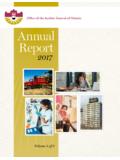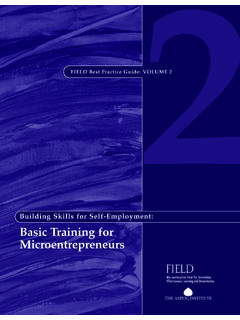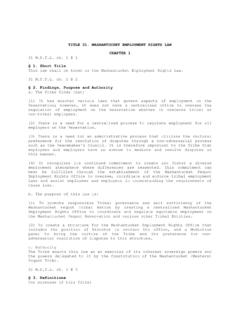Transcription of 3.04 Employment Ontario - Auditor General of …
1 Employment OntarioChapter 3 Section 3 VFM Section of Advanced Education and Skills SummaryEmployment Ontario offers a suite of programs designed to provide Employment and training services to job seekers and employers, apprentice-ship training to students seeking certification and Employment in a skilled trade, and literacy and numeracy skills to people who lack basic education necessary for Employment . These programs are funded by the Ministry of Advanced Education and Skills Development (Ministry), and the majority are delivered by third-party agencies. In order to support the Province s economic growth and help ensure Ontarians have long-term sustainable Employment , it is important that these programs meet the needs of Ontario s current and future labour market. While Ontario s annual unemployment rate ( in 2015) has generally been in line with the national average, its youth unemployment rate ( in 2015) has been con-sistently higher than the national average over the last decade by two percentage points.
2 Our audit found that key programs offered by Employment Ontario are not effective in helping Ontarians find full-time Employment . Although the Ministry is redesigning some of its existing pro-grams, more attention is needed to increase their effectiveness and improve efficiency. Specifically, the Ministry needs to take additional steps to increase completion rates for apprentices, and to help people sustain long-term Employment in their field of training. We also noted that the Ministry lacks the detailed and timely labour market infor-mation necessary to both improve existing pro-grams and develop new ones to meet the current and future labour needs of Ontario . Some of the significant issues we found include: Majority of Employment and training program clients unsuccessful in finding full-time Employment in their chosen career. The objective of Employment Ontario s Employment Service program is to find long-term sustainable Employment for clients.
3 For 2015/16, at the time of comple-tion of the program, only 38% of clients were employed full-time and only 14% had found Employment in either their field of training, a professional occupation or a more suit-able job than before the program. Similarly, in Employment Ontario s Second Career program, which is intended to retrain unem-ployed and laid-off workers for high-demand jobs, 35% of clients reported being employed when they completed the program, but only 17% were employed full-time, and only 10% were employed in either their field of training, a professional occupation or a more suitable job at time of completion of the program. 251 Employment OntarioChapter 3 VFM Section Overpayments to clients who do not com-plete programs are not being recovered. Participants in Employment Ontario s Second Career program who receive funding for retraining but do not regularly attend their program or provide receipts are required to repay the Ministry.
4 In the last three fiscal years, $ million that should have been repaid has been written off as uncollectible. Less than half of the people who begin an apprenticeship program in Ontario complete it. The average completion rate for apprentices in Ontario (from 2011/12 to 2015/16) was about 47%. Completion rates for voluntary trades were significantly lower than for compulsory trades (35% vs. 59%). Comparable completion results from other jurisdictions were not available because prov-inces do not follow a single standard method to calculate completion rates for apprentices. Ministry needs to better analyze and address reasons for low apprenticeship completion rates. The Ministry does not review apprentice completion rates by in-class training provider or employer, and it does not compile and analyze survey results separately (for the majority of questions) for those that completed their apprenticeship program and those that withdrew.
5 Such analyses would enable the Ministry to identify those in-class and on-the-job training providers that may not be preparing apprentices for success, and assess the reasons why apprentices did not complete their apprenticeship. We analyzed apprenticeship completion rates by employer and found that, for employers who have spon-sored at least 50 apprentices since the begin-ning of the program, there were approximately 100 employers that had a low success rate ( , less than 20% of their apprentices complete their apprenticeship) but were still actively training almost 4,800 apprentices. Financial incentives to employers may not be encouraging apprentice certification. In 2015/16, about 60% ($205 million) of all apprenticeship funding was paid to employers through a combination of the Apprenticeship Training Tax Credit, a signing bonus and a completion bonus. The first two financial incentives support apprentices entering the program, but are not tied to employers ensuring apprentices complete the program.
6 The completion bonus, which is more closely aligned with the Ministry s goal of increasing the number of apprentices that get certified, is half the amount of the signing bonus. Number of apprentices at risk of non-com-pletion remains high even after implemen-tation of a monitoring strategy. The Ministry began monitoring at-risk apprentices in Nov-ember 2014. At that time, 16,350 apprentices were identified as being at risk of not complet-ing their apprenticeships. About 68% of these cases were resolved by having the apprentice exit the system, in effect cleaning out the Ministry s database. However, by June 2016, the number of apprentices at risk increased to 39,000. Of these, 20,800 were apprentices identified under the same definition as that used in November 2014, and an additional 18,200 apprentices were identified under an expanded definition. Regardless of the defin-ition used, the number of at-risk apprentices has increased during the last years since the monitoring strategy was introduced.
7 Ministry s monitoring of apprenticeship training is limited. Although the Ministry has processes in place to assess an employer s qualifications at the time they submit an application to train an apprentice, it relies on employers to self-report any changes that may affect their ability to provide sufficient train-ing, such as a change in the number of trainers available to the number of apprentices. Local Ministry offices we visited during our audit confirmed that their involvement with employ-ers is very limited and noted that they visited employers primarily when complaints were 2016 Annual Report of the Office of the Auditor General of Ontario252 Chapter 3 VFM Section With regard to in-class training, the Ministry evaluates whether training delivery agents have the tools and resources to deliver courses when they are initially approved for funding, but any monitoring by the Ministry after that point is complaint driven.
8 Ministry staff informed us that they do not directly assess whether instructors are qualified and whether the courses are taught according to the curriculum, nor do they compare the quali-fication exam pass rates by training delivery agent to identify those with comparatively high failure rates. Ministry lacks necessary data to ensure Employment Ontario programs meet cur-rent and future labour needs. The Ministry does not collect or analyze regional informa-tion on labour force skills supply and demand to identify what jobs will have a shortage of skilled workers. According to the Ministry, there are few reliable sector-wide sources of information on employers anticipated labour needs. The Ministry does publicly report cer-tain labour market information every month (such as unemployment rates by metropolitan areas, and rate of Employment growth by highest level of education completed and major occupation groupings); however, this information is not specific to particular jobs or trades to allow for an assessment of the supply or demand for specific occupations.
9 Also, every four years the Ministry reports on the likelihood of people finding Employment in various jobs in Ontario . Other provinces, such as British Columbia and Alberta, report projected demand by occupation for a 10 year period that they update annually and biannu-ally respectively. This report contains 18 recommendations with 35 action MINISTRY RESPONSEThe Ministry appreciates the work of the Auditor General and her staff in examining Employment Ontario s programs and services. We value the observations and recommenda-tions provided as a result of this audit. While the Employment Ontario network helped approximately one million Ontarians in 2015/16, including over 122,800 employers across Ontario , we agree there is opportunity to transform Ontario s Employment and train-ing system to better meet client need, improve outcomes and ensure our resources are targeted most effectively. We remain committed to ensuring clients get the skills they need to find Employment , including providing effective supports to help apprentices complete their training and become qualified journeypersons.
10 The Ministry is undertaking a multi-faceted, long-term trans-formation agenda to modernize and integrate Ontario s Employment and training the recommendations of the Highly Skilled Workforce Expert Panel, the Min-istry is developing and implementing a strategy to help the workforce adapt to the current and future demands of a technology-driven know-ledge Ministry is committed to reviewing and continuously improving client outcomes and ensuring program alignment with current and future labour market demands. As such, the Ministry has already begun to take the following steps: improved information technology support to help the Ministry better manage client cases, and reduce the number and level of potential overpayments to clients; exploring new and enhanced sources of labour market information to identify the most high-demand occupations and better support Ministry planning; reviewing employer supports for apprentice training to support completion rates and increase apprenticeship opportunities; and increased the criteria to expand the scope of apprentices to be monitored to those for 253 Employment OntarioChapter 3 VFM Section early intervention and supports could lead to timely completion.
















